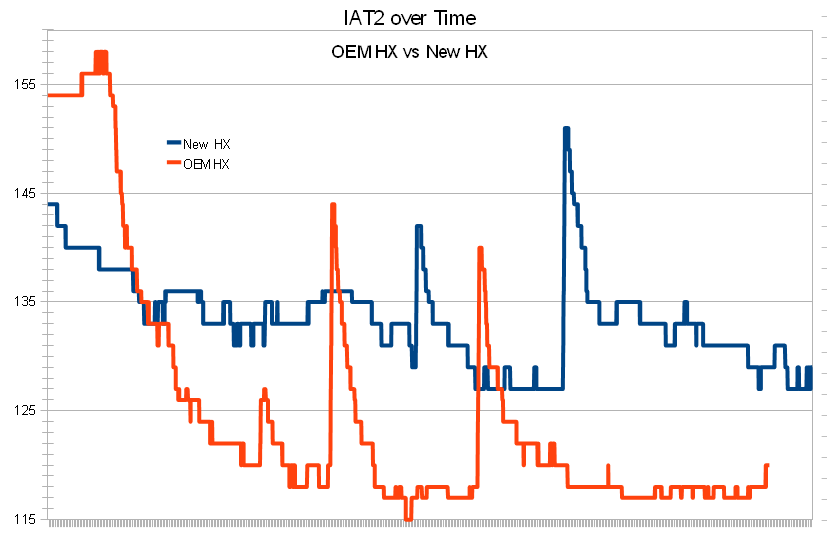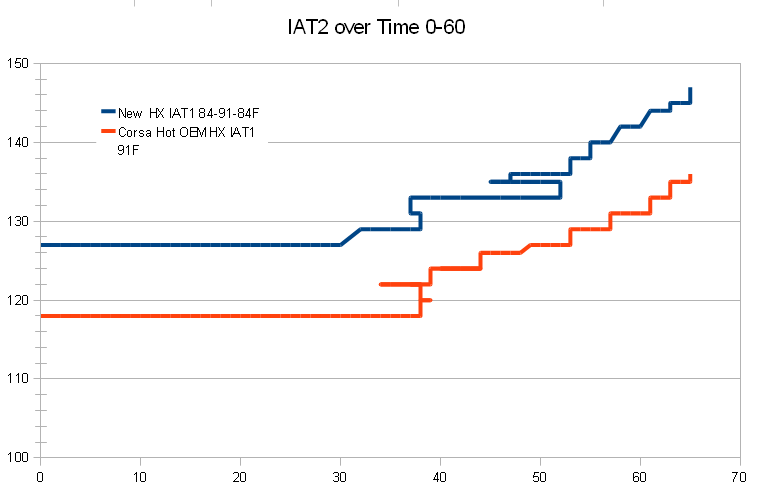Initial IAT2 trends with the new Intercooler Heat Exchanger appear to be somewhat worse than the OEM intercooler heat exchanger.
This is disappointing since tuners have reported improvements with similar heat exchangers. There may be more variables at play here, but my first tests suggest the new HX as installed is not performing better than the OEM HX.
To compare the two I considered HP Tuners VCM Scanner data captures for the OEM heat exchanger on a hot day (heat soaked) to a similar run with my replacement heat exchanger (a flexalite 45321). IAT1 temps, which is air at the MAF, were similar for each run, but the runs were certainly on different days etc. Thanks to HP Tuners for updating their comma delimited export capability to make this easier!
The first chart shows overall trend over time for my normal data capture run. The spikes are acceleration runs. The X axis is actually the sample time for the scan, which runs from 0-65K so I simply left it off for clarity. The Y axis is IAT2 temps in degrees F.
The new HX appears to reach constant IAT2 around 127F. The OEM HX reached constant IAT2 around 117F.
This is a comparison side by side over time during a 0-60 mph run with each:
The OEM HX starts at a lower temp, but the two HX’s appear to show similar trends for the expected increase in IAT2’s during hard acceleration.
It is possible that the system is still not air-free, and I will retest after a week of continued monitoring.



I took the advice from the article I posted before and tweaked the flow rate of the pump… I found that slight variations of the flow rate dramatically changed the recovery temperature read at IAT2… my guess is that the flow characteristics of the new HX changed the flow rate of the fluid through the inter-cooler (probably moving too fast)… also I’m surprised you didn’t change your Dexa mix from 50/50 to 80/20
Good points Richard.
I’ll have to consider the flow rate question and how to adjust. I recall the article discussed adding a resistor to the circuit.
I am also thinking of adding a inline reservoir to add more fluid and which might add a bit more resistance to flow.
I didn’t want to change the mix from the recommended 50/50 so that we could see the comparison with the mix held constant as a variable.
This is very interesting, this result is counter to what you would think. Is there an easy way to measure flow rates? Would some sort of flow restrictor at the exit of the cooler be able to slow down the flow in order that it cools more efficiently? I hate the idea of having another orfice (like the bolt with a hole in it), but could something like that slow the flow?
Yes. Although if you consider that you are rotating water between an oven (the supercharger) and a refrigerator (the heat exchanger) then it makes sense that you would want it to spend as much time out of the oven as possible.
There is not a simple way of measuring flow rate — I would need to add a flow gauge to do so.
The pointer Richard shared suggests slowing the pump down by adding a resister to the pump relay circuit and so reducing the current to the pump. I agree I am attracted to simply putting a valve in the flow or as you say some physical resistance, but then the pump has to work against the pressure head which seems counter-productive. Turning down the pump speed is logical.
Another thought — the OEM radiator style HX likely held 1 quart of the total of 2.6 quarts of coolant in the OEM system. The new HX may actually hold less, which would be the wrong direction in a coolant-light system already.
It may be worth reconsidering putting both HX in the car in series (assuming they will fit)… it may fix both your flow issue and capacity issue… better get on it before it gets hot here in Texas! 🙂
I have considered just that. However the OEM HX only holds 2 quarts, so not much help.
My current plan is to retest at the end of the week for baseline confirmation. Assuming that tests shows consistent temps then my next move would be to add more delay outside the intercooler, like an inline 1 gal tank, while not slowing flow through the intercooler.
My intuition is the laminova tubes are better at putting heat into the fluid than the hx is at taking out; so the longer the fluid is out of the heat the better.
Pingback: Cadillac STS-V Intercooler cooling – gathering more parts | Cadillac Conversations
For what its worth, in the spirit of “testing”…. slowing your pump down will be much cheaper than adding capacity…
For the trouble they seem similar.
Slowing the pump down reqs putting the car up, taking off the deflector, and rewiring the pump, preferrably with adjustable amperage. Adding an inline tank reqs putting the car up, deflector off, and bolting in a small tank with new hoses to and from.
Do you know an easy way to vary pump speed that I am missing? Would be sweet if hp tuners allowed % pump speed adjust!
Reading the lightning forums the faster the flow the better for the intercooler heat removal, but perhaps pulling more heat out than the hx can handle and so leading to a higher equilibium temp. I still plan to retest current config in case it has settled out a bit.
I would also like to have a flow meter on the system, and a water temp gauge to tell more about exactly what is happening, but those would effect flow as well lol
If you find a flow meter that doesn’t cost a few hundred dollars please share it – I haven’t been able to find one… I’m at the point where I may just do a bucket test to approximate the flow, but I’d prefer a flow meter.
I had no idea the pump was in such a bad location on the STS… in the XLR its right on top by the fuse box so its really easy to deal with.
As for the speed controller… I am using a PWM controller used in hobby RC cars and robotics – not only will it control speed, but it has the added benefit of not using any more electricity than needed to run the pump at the speed you’d like.
In my upgrades, I also upgraded to a 17gpm pump… my testing resulted in having the controller set to about 40% duty cycle to get the best results… I don’t know what the actually GPM of the system is, but if we just did some rough math thats about 6gpm… so I’m considering putting the stock pump back on to see if I get similar results.